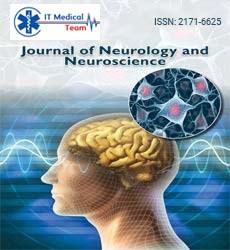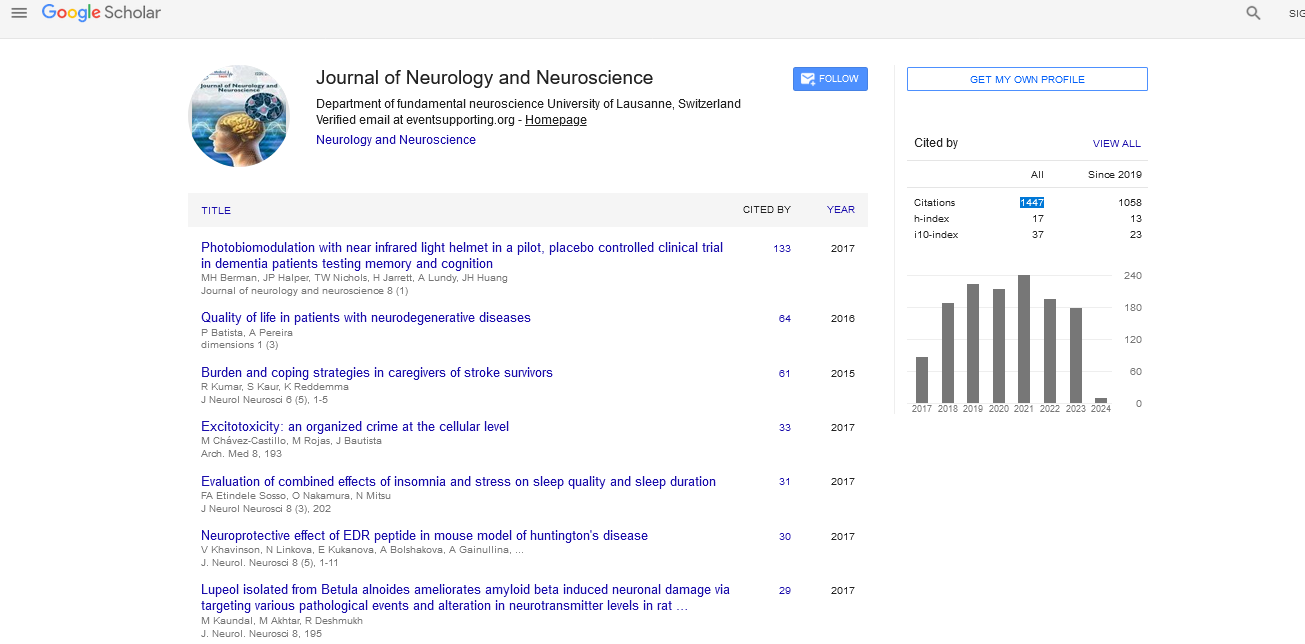Perspective - (2024) Volume 15, Issue 5
Focal neurology understanding localized brain disorders
Agnieszka Nowacka*
Department of Neurosurgery, Nicolas Copernicus University in Toruń, Curie Skłodowskiej 9, 85-094 Bydgoszcz, Poland
*Correspondence:
Agnieszka Nowacka, Department of Neurosurgery, Nicolas Copernicus University in Toruń, Curie Skłodowskiej 9, 85-094 Bydgoszcz,
Poland,
Email:
Received: 03-Oct-2024, Manuscript No. ipjnn-24-15388;
Editor assigned: 05-Oct-2024, Pre QC No. P-15388;
Reviewed: 18-Oct-2024, QC No. Q-15388;
Revised: 24-Oct-2024, Manuscript No. R-15388;
Published:
31-Oct-2024
Introduction
Focal neurology is a specialized branch of neuroscience
that deals with localized brain disorders, which can result in
specific neurological deficits depending on the area of the
brain affected. This article aims to delve into the intricacies
of focal neurological disorders, exploring their causes,
symptoms, diagnostic methods, and treatment options.
Localized brain disorders refer to conditions that affect
specific areas of the brain, leading to a range of neurological
symptoms that can include motor, sensory, cognitive, and
behavioral changes. These disorders can arise from various
causes, including structural abnormalities, vascular issues,
infections, and degenerative diseases. Vascular Issues:
Strokes and Transient Ischemic Attacks (TIAs) can lead
to focal neurological deficits. An ischemic stroke occurs
when blood flow to a specific brain region is obstructed,
while a hemorrhagic stroke involves bleeding in the brain.
Brain tumors, whether malignant or benign, can compress
adjacent brain structures, leading to localized neurological
symptoms. Conditions like encephalitis and meningitis can
result in localized brain dysfunction depending on the areas
affected. Disorders such as Alzheimer’s disease, Parkinson’s
disease, and multiple sclerosis can also present with focal
symptoms. Traumatic brain injury can lead to localized
deficits based on the injury's location and severity [1].
Brain disorders encompass a wide range of conditions
that affect the structure and function of the brain, leading
to cognitive, emotional, and physical impairments. These
disorders are broadly categorized into neurodegenerative
diseases, mental health conditions, neurological disorders,
developmental disorders, and brain injuries. The complexity
of the brain means that even small disruptions in its
function can have significant impacts on an individual's
quality of life. Understanding the causes, mechanisms, and
treatment options for these conditions is a critical area of
medical research [2].
Neurodegenerative diseases, such as Alzheimer’s disease,
Parkinson’s disease, and Amyotrophic Lateral Sclerosis
(ALS), are characterized by progressive loss of neurons in
specific regions of the brain. These conditions often lead
to memory loss, motor dysfunction, and cognitive decline.
Advances in imaging and molecular biology have identified
abnormal protein aggregation and inflammation as key
contributors to these diseases. Despite extensive research,
most neurodegenerative conditions currently have no cure,
and treatments focus primarily on symptom management
and slowing disease progression [3].
Mental health disorders, including depression,
anxiety, and schizophrenia, significantly impact brain function and societal well-being. They often stem from a
combination of genetic, environmental, and psychological
factors. Similarly, developmental disorders such as
Autism Spectrum Disorder (ASD) and Attention-Deficit
Hyperactivity Disorder (ADHD) arise during childhood,
affecting learning and behavior. These disorders highlight
the importance of early diagnosis and tailored therapeutic
approaches, including Cognitive-Behavioral Therapy
(CBT) and pharmacological interventions, to improve
outcomes. Conditions like epilepsy, Multiple Sclerosis
(MS), and Traumatic Brain Injuries (TBI) highlight the
diverse nature of brain disorders. Epilepsy, caused by
abnormal electrical activity in the brain, leads to recurrent
seizures, while MS involves immune-mediated damage to
the nervous system. TBIs, often resulting from accidents
or sports injuries, can lead to long-term cognitive and
emotional challenges. Advances in neuroimaging and
neurorehabilitation offer hope for better management of
these conditions, emphasizing the need for personalized
care strategies [4].
Description
In cases of tumors, vascular malformations, or refractory
epilepsy, surgical intervention may be necessary. Surgical
techniques can range from tumor resection to stereotactic
radiosurgery. Encouraging lifestyle changes can also play
a crucial role in management, particularly for vascular
conditions. These may include dietary modifications,
regular exercise, and smoking cessation. The prognosis
for localized brain disorders varies significantly based on
several factors, including the cause of the disorder, the
brain regions involved, the age of the patient, and the
timeliness of treatment. Outcomes for strokes can be
improved with rapid intervention. Early rehabilitation can
enhance recovery potential, although some patients may
experience long-term deficits. The prognosis for patients
with brain tumors depends on the tumor type, location,
and whether it can be completely resected [5].
Emerging research is transforming the landscape
of brain disorder diagnosis and treatment. Innovations
like neuroimaging, gene therapy, and brain-computer
interfaces are paving the way for earlier detection and
novel therapeutic approaches. Additionally, the gut-brain
axis and neuroinflammation are gaining attention for their
roles in brain health. As global healthcare systems prioritize
mental health and neurological research, the future holds
promise for reducing the burden of brain disorders and
improving patient quality of life. Neurodegenerative
disorders tend to have progressive courses, and while
symptom management is critical, current treatments may
not halt disease progression.
A 65-year-old male presented with sudden-onset
weakness of the right arm and leg, along with difficulty
speaking. Imaging confirmed an ischemic stroke in the left
hemisphere. The patient was treated with thrombolytic,
followed by a rehabilitation program that included
physical and speech therapy. After six months, he regained
significant function in his arm and improved speech. A
50-year-old female with progressive memory loss and
personality changes was diagnosed with a meningioma
affecting the frontal lobe. After surgical resection, her
cognitive function stabilized, and she received follow-up
cognitive rehabilitation to assist with memory strategies.
A 30-year-old woman experienced episodes of numbness
and weakness in her limbs, attributed to multiple sclerosis.
Disease-modifying therapy was initiated, along with a
comprehensive rehabilitation program to address her
mobility and functional needs.
Conclusion
Focal neurology plays a critical role in understanding
and managing localized brain disorders. With advances in
imaging technology, treatment options, and rehabilitation
techniques, outcomes for patients can be significantly
improved. Early recognition and intervention are key
to enhancing recovery and quality of life for individuals
affected by these complex conditions. As research continues
to evolve, the field of focal neurology will undoubtedly
yield new insights into the brain's remarkable adaptability
and resilience.
References
- Nicola R, Okun E. Adult hippocampal neurogenesis: One lactate to rule them all. Neuromolecular Med. 2021; 23(4):445-448.
Google Scholar, Crossref, Indexed at
- Boulenger V, Shtyrov Y, Pulvermüller F. When do you grasp the idea? MEG evidence for instantaneous idiom understanding. Neuroimage. 2012; 59(4):3502-13.
Google Scholar, Crossref, Indexed at
- Cervetto S, Díaz-Rivera M, Petroni A, et al. The neural blending of words and movement: Event-related potential signatures of semantic and action processes during motor–language coupling. J Cogn Neuroscience. 2021; 33(8):1413-27.
Google Scholar, Crossref, Indexed at
- Hauk O, Pulvermüller F. Neurophysiological distinction of action words in the fronto‐central cortex. Hum Brain Mapp. 2004; 21(3):191-201.
Google Scholar, Crossref, Indexed at
- Buccino G, Riggio L, Melli G, et al. Listening to action-related sentences modulates the activity of the motor system: a combined TMS and behavioral study. Cogn Brain Res. 2005; 24(3):355-363.
Google Scholar, Crossref, Indexed at





